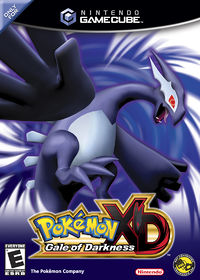Pokémon XD: Gale of Darkness

| |
| Pokémon XD: Gale of Darkness | |
| Developer | Genius Sonority |
| Publisher | Nintendo |
| System | Nintendo Gamecube |
| Release Date | JP August 4, 2005 US October 5, 2005 AU November 10, 2005 EU November 18, 2005 |
| Rating | ESRB: E |
Pokémon XD: Gale of Darkness is the 2005 sequel to Pokémon Colosseum. It expands on the original by featuring more Shadow Pokémon and a new RPG story within the same canon as the previous game.
Story[edit]
Five years have passed since Wes's defeat of Cipher in Pokémon Colosseum, but Cipher is still active. The protagonist is a young man named Michael, whom had just learned about Shadow Pokémon from his mentor, Professor Krane. Krane is soon kidnapped by agents of Cipher, so Michael embarks on a quest across Orre to save him, while armed with a Snag Machine and Aurea Reader. Michael must eventually face Shadow Lugia, the ultimate Shadow Pokémon that apparently cannot be purified.
Gameplay[edit]
The game has a story mode which uses many of the same locations as the previous game and similar gameplay. There are a variety of different Shadow Pokémon that can be snagged from enemies during battles, and it is now possible to obtain wild Pokémon at special areas called Poké Spots. Shadow Pokémon themselves also have different Shadow Moves aside from the default Shadow Rush from the previous games, although these moves are lost in purification. A new Purify Chamber makes it easier to purify up to nine Pokémon at once. This game also contains several new minigames and other features and early appearances by the fourth generation Pokémon Munchlax and Bonsly. Pokémon XD also has other modes which contain the usual multiplayer battle-focused options.
Connectivity[edit]
Like Colosseum, Pokémon XD can connect to any of the third generation color versions (including FireRed and LeafGreen). This can be used to fight with Pokémon from the GBA games, and it can also be used to trade Pokémon between the games once the Shadow Pokémon are purified. Shadow Pokémon cannot be traded until purified.
Legacy[edit]
Sequels[edit]
It was followed by Pokémon Battle Revolution, which did not have a story mode and instead returned these tie-in games to their stadium-based roots.